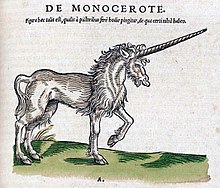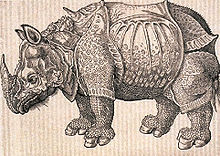Historia animalium (Gessner book)

Historia animalium ("History of the Animals"), published in
Overview

The Historia animalium was Gessner's magnum opus, and was the most widely read of all the Renaissance natural histories. The generously illustrated work was so popular that Gessner's abridgement, Thierbuch ("Animal Book"), was published in Zurich in 1563, and in England Edward Topsell translated and condensed it as a Historie of foure-footed beastes (London: William Jaggard, 1607).[1] Gessner's monumental work attempts to build a connection between the ancient knowledge of the animal world, its title the same as Aristotle's work on animals, and what was known at his time. He then adds his own observations, and those of his correspondents, in an attempt to formulate a comprehensive description of the natural history of animals.[2]
Gessner's Historia animalium is based on
In his larger works Gessner sought to distinguish fact from myth and popular misconceptions,
Historia animalium showed the animals' places in history, literature and art. Sections of each chapter detailed the animal and its attributes, in the tradition of the emblem book. Gessner's work included facts in different languages such as the names of the animals.[5]
Fantastical creatures

There have been various academic studies relating to Gessner's inclusion of fantastical creatures in the volumes, such as the
Gessner was aware of fakery in the curio shops market, where dried rays were manipulated to look like dragons (for example Jenny Hanivers).[8] There may have also been fake mermaid-like creatures being imported from China by the Dutch.[9]
Also, commercial interests may also have motivated publishers or authors such as Gessner to include such creatures to boost sales.[6] But Gessner was known for meticulously checking facts, and it has been suggested that publishers may have interpolated material when Gessner was in no condition to gainsay them, since the author was already morbidly ill by the time of these publications.[7] In fact there is the example of the Su of Patagonia, posthumously inserted in the 1603 Frankfurt edition.[7]
Contents
- Volume 1: four-footed animals(viviparous quadrupeds) (1551).
- Volume 2: amphibia) (1554).
- Volume 3: Birds(1555).
- Volume 4: aquatic animals(1558).
- Volume 5: posthumously 1587).[4]
Illustrations

The colored woodcut illustrations were the first real attempts to represent animals in their natural environment. It is the first book to illustrate fossils.[5][10]
Gessner acknowledges one of his main illustrators was
Censorship
There was
References
- ^ a b c d "Featured book archive: Historia animalium libri I-IV. Cum iconibus. Lib. I. De quadrupedibus uiuiparis. Zurich: C. Froschauer, 1551. N*.1.19(A)". Cambridge University Library. Archived from the original on 13 January 2019. Retrieved 29 November 2014.
- ^ a b c Huxley, 2007. Pages 71–75
- ^ a b c d e "Conran Gessner biography". Retrieved 2008-09-17.[permanent dead link]
- ^ a b Pettitt 2014.
- ^ a b Anzovin, p. 366 item 5210 The first fossil illustrations were contained in the Historia animalium, published in 1551 by Swiss physician and naturalist Conrad von Gessner.
- ^ S2CID 54212091.
- ^ )
- ^ Gudger (1934), pp. 516–517.
- ^ Gudger (1934), p. 512.
- ISBN 1-84188-254-2, p. 46 Gessner’s classical training taught him to give pride of place to naming and classifying the fossils he described. Most importantly, he was concerned with precise identification. His book was the first to present fossil illustrations so students may more easily recognize objects that cannot be very clearly described in words.
- S2CID 27904499.
- ^ Schmitt, p. 46,
Bibliography
- Anzovin, Steven (2000). Famous First Facts. H. W. Wilson. ISBN 0-8242-0958-3.
- ISBN 0-942299-91-4.
- Eamon, William (1994). Science and the Secrets of Nature: Books of Secrets in Medieval and Early Modern Culture. Princeton University Press. ISBN 0-691-02602-5.
- Fudge, Erica (2004). Renaissance Beasts: Of Animals, Humans, and Other Wonderful Creatures. University of Illinois Press. ISBN 0-252-02880-5.
- Gmelig-Nijboer, Caroline Aleid (1977). Conrad Gessner's 'Historia animalium': an inventory of renaissance zoology. Meppel.
- ISBN 04862270-1-4.
- Gudger, E. W. (1934). "Jenny Hanivers, Dragons and Basilisks in the Old Natural History Books and in Modern Times". The Scientific Monthly. 38 (6): 511–523. JSTOR 15490
- Huxley, Robert; et al. (2007). The Great Naturalists. Thames & Hudson. ISBN 978-0-500-25139-3.
- Jardine, Secord; et al. (1996). Cultures of Natural History. Cambridge University Press. ISBN 0-521-55894-8.
- Library Company of Phil, Steven (2000). Legacies of Genius: A Celebration of Philadelphia Libraries: A Selection of Books, Manuscripts, & Works of Art. ISBN 1-151-45471-0.
- Ogilvie, Brian W. (2006). The Science of Describing: Natural History in Renaissance Europe. University of Chicago Press. ISBN 0-226-62087-5.
- ISBN 1-59691-071-2.
- Pettitt, George A. (18 February 2014). "Conrad Gesner". Encyclopædia Britannica. Retrieved 26 September 2017.
- Rudwick, Martin J.S. (1976). The Meaning of Fossils. University of Chicago Press. ISBN 0-226-73103-0.
- Schmitt, Charles B.; et al. (1990). The Cambridge History of Renaissance Philosophy. Cambridge University Press. ISBN 0-521-39748-0.
- Topsell, Edward; Gessner, Konrad; et al. (1967). The history of four-footed beasts and serpents and insects. Da Capo Press. ISBN 0-306-70923-6.

